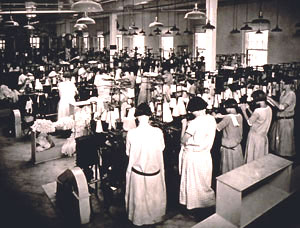
Loudon County
Established on June 2, 1870, Loudon County was created from portions of Roane, Monroe, and Blount Counties. On September 5, the county court was organized, and the Loudon (formerly Blair's Ferry) town square was donated as the site for the courthouse. The county court selected the building plan submitted by A. C. Bruce, and brothers J. Wesley and Ira Napoleon Clark built it for $14,200. By September 1872 the courthouse was ready for occupancy and has served since as the seat of government.
Comprising 229 square miles, Loudon County lies on both sides of the Tennessee River and extends north to the Clinch River. The territory south of the river contains the fertile valleys of Sweetwater, Pond, Fork, and Town Creeks. To the north are the broad bottoms of the Tennessee River. The Little Tennessee River also passes through the county. The first occupants were Native Americans. The part of the county lying south of the rivers formerly belonged to the Hiwassee District and was not settled by white men until 1819-20, but settlements were made on the north banks of the Tennessee and the Little Tennessee before 1800.
In 1790 white families settled on the north bank of the Tennessee River near the present location of the Loudon bridge. The William Tunnell family was the first to settle on the south side of the river. As other settlers, including the Carmichaels and Blairs, came, a ferry was established, and the settlement was called Blair's Ferry. In 1850 a formal plan for the town was established, and the name was changed to Loudon in 1858. The East Tennessee and Georgia Railroad was built to Blair's Ferry in 1852, and by 1855 a railroad bridge spanned the river northward, and the flourishing river trade declined.
Lenoir City traces its origins from the extensive land holdings of General William B. Lenoir, a prominent and wealthy North Carolinian who served at the battle of Kings Mountain. For his service Lenoir received 5,000 acres of land, which he deeded to his eldest son, Major William B. Lenoir, who moved his family to the area in 1810. By 1821 Major Lenoir had developed a prosperous and well-managed plantation widely known for cattle and hog production, as well as several small industries, including a cotton mill and a flour mill. When Major Lenoir died in 1852, four of his sons formed William Lenoir and Sons and controlled about 2,700 acres of the estate. Eventually, the land was sold to the Lenoir City Company, which developed the town. Lenoir City was incorporated in 1907.
In October 1813 an act of the state legislature established the town of Morgantown, located at the mouth of Baker's Creek, on land owned by Hugh and Charles Kelso. Originally called Portville, the town changed its name to honor Gideon Morgan Sr., a Revolutionary War soldier. The town did not survive the economic decline it suffered in the late 1800s, when the Louisville and Nashville Railroad was built through the area and ended the thriving river trade. When Tellico Dam was built in the 1970s, the waters of Tellico Lake inundated the town site.
In the fall of 1821 William Knox and Jacob Pearson established the town of Philadelphia six miles southwest of Blair's Ferry. The town's largest and most successful industry was the Philadelphia Hosiery Mill, established by Edward Waller in 1921. For more than forty years, the corporation expanded and grew, but in the early 1960s, the mill was sold and reopened as Bar Knit Hosiery, which closed in the early 1970s.
During the 1800s, the town of Greenback was established as the result of railroad construction. It occupied land once owned by Robert Thompson and J. B. Hall. Greenback is primarily an agricultural community, but one with strong civic pride.
Loudon County did not escape the destruction and devastation of the Civil War. No major battles were fought in Loudon County, but there were massive troop movements through the area. As the only East Tennessee railroad bridge across the Tennessee River, the bridge at Loudon provided a strategic link between Knoxville and Chattanooga. The bridge remained under constant surveillance during the war and was partially burned twice by retreating Confederate forces.
Following the battle of Chickamauga on September 19-20, 1863, General James Longstreet moved north to capture Knoxville, and Union General Ambrose Burnside sent ten thousand men to the Loudon area. During October and November, cavalry skirmishes took place around Philadelphia and Loudon, as the armies moved north. After the battle of Knoxville, Confederate troops burned the Loudon railroad bridge and sank three locomotives and forty-eight cars to deny General William T. Sherman access to the bridge. Loudon County and East Tennessee remained under Union control for the rest of the war.
Industrialization developed slowly after the Civil War. The Lenoir family rebuilt the depot and general store burned by Union troops and built a new burr and roller flour mill to replace the one that burned in 1860. The Lenoir City Company, founded in 1890, attracted new industries, including the Bass Foundry and Machine Shop, which eventually built railroad cars for the Southern Railroad Company under the name Lenoir Car Works. The Holston Manufacturing Company briefly operated a hosiery mill. The Tennessee Valley Authority completed Fort Loudon Dam in 1943 and added Tellico Dam in the 1970s. The creation of Tellico Lake and Tellico Village, a residential community, contributed significantly to the local economy.
Loudon's progress was slower and tied to agriculture. In 1906 Charles H. Bacon established Loudon's first significant industry, a hosiery mill. Shortly thereafter, the Lutz Mantel Company and Don P. Smith Chair Factory also were established; only the chair factory remains. In recent years, several new industries have located in Loudon: Viskase Corporation, Maremont, the Staley Corporation, Yale Security, and Kimberly Clark. From 1990 to 2000, the county's population grew by over 25 percent, reaching 39,086.



